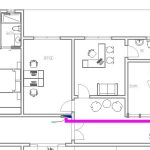There are a number of important considerations during CCTV room design, including equipment selection, placement and ergonomics. Here are some steps to follow while design of a CCTV room:
Identify the purpose of the room:
The first step in designing a CCTV room is to identify its purpose. Is it used to track employees, secure premises or monitor production processes? The goal helps determine the type and number of cameras needed, the layout of the room and the equipment needed.
Determine the number of cameras in your system:
Once the purpose of the CCTV room is determined, the next step is to determine the number of cameras you want to incorporate in your CCTV Room. This information will help you to select number of LED or LCD screens you need for monitoring.
How to calculate number of screens?
The quantity of cameras and size of each screen will help you to decide number of screens you need for this rooms. For example, you have 200 cameras and you want to view it on 40″ screen so it means you can view 16 cameras on each screen. Simply you can divide 200 cameras by 16 cameras on each screen so you will get result of 12.5 which means atleast you need 13 screens to cater 200 cameras.
No. of screen required for given cameras = No of cameras / camera views on each screen
200 /16 = 12.5
Equipment selection:
For selection of equipment, First we need to find out the appropriate size of Network Video Recorder (NVR). Most common ratings are given below:
16 Channel NVR
32 Channel NVR
64 Channel
However, each channel can cater one camera, so you have to divide your number of cameras by number of channel in your NVR. For example, for 200 cameras if you are using 64 channel NVR, simply just divide number of cameras by number of channels of your NVR.
Number of NVRs required = Number of cameras / No. of channels of each NVR.
N0s. of NVRs required = 200 / 64
Nos. of NVRs required = 3.125
Plan the layout:
Plan the room layout so that all cameras are positioned correctly and users can see all screens unobstructed. Consider the location of equipment racks, monitor placement and driver seat placement.
Installing the Equipment:
Finally, Once the project is complete, install the equipment and test it to make sure everything is working properly. It is important to follow the manufacturer’s installation recommendations and ensure that all equipment is properly grounded.
Train users: Finally, train users to operate the equipment and ensure they understand monitoring, recording, and incident response procedures. Regular training and updates are essential to keep users abreast of new technologies and procedures.

An experienced electrical professional having more than 8 years of experience of the industry in diverse fields of engineering including Electrical Design & Consultancy, Audit & Inspection, Execution of Construction Projects having expertise in designing of HighRise buildings, Residential & Commercial buildings, Offices, Schools, Restaurants and some Industrial projects



